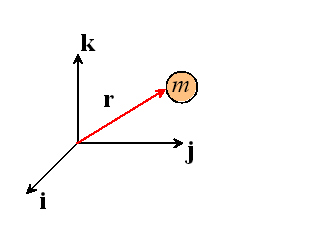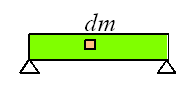
EN4: Dynamics and Vibrations
Division of Engineering
Brown University
1.2 Fundamental Postulates of Classical Mechanics
 Newton’s Laws of Motion
Newton’s Laws of Motion
All the ideas that will be discussed in EN4 can (and will) be deduced from
Newton’s laws of motion:

1. When the sum of the forces acting on a particle is zero, its
velocity is constant
2. The sum of forces acting on a particle of constant mass is equal to
the product of the mass of the particle and its acceleration
3. The forces exerted by two particles on each other are equal in
magnitude and opposite in direction.
To understand Newton’s laws of motion, then, we must discuss what we mean by a
`particle;’ a `force;’ and we must find a way to describe accelerations.
Finally, we need to understand how to use the laws of motion to solve problems.
 The Particle
The Particle
Definition: A particle is a concentrated mass at some position in space. The
inertial mass of a particle is defined through Newton’s second law.

A particle has two properties:
(i) its position (a vector) r
(ii) its mass (a scalar) m
There is actually no such thing as a particle, but many mechanical systems can be
idealized as systems of particles to predict approximately how they behave. Some examples
of systems that can be idealized as particles are:
(i) Orbiting planets
As you see, an object need not necessarily be small to be idealized as a particle. As a
general rule, we idealize a body as a particle if
Hint: until Section 5 of this course, we will idealize everything as a
particle, so you don’t need to decide for yourself!
 Forces
Forces
Definition: A force is something that causes a particle to accelerate. Forces
are defined through Newton’s second law.
A force has two properties:
(i) Magnitude
(ii) Direction
It is therefore a vector.
When solving problems in dynamics, we start by idealizing our system (either as one or
more particles, or for more complex problems, as rigid bodies). We then work out the
forces acting on each particle. Forces may arise from a number of different effects,
including
(i) Gravity
(ii) Electromagnetism or electrostatics
(iii) Buoyancy
(iv) Wind or fluid induced drag or lift forces
(v) Forces induced by deformable elements, such as springs
(vi) Contact forces or constraint forces, which force the particle to move in along a
prescribed path
(vii) Friction
We will assume that you are comfortable with identifying the forces acting in a system
as a result of having survived EN3, and that you are also happy with expressing forces as
vectors.

![]() Newton’s Laws of Motion
Newton’s Laws of Motion




